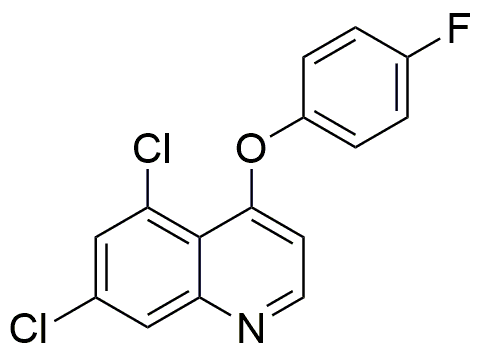Quinoxyfen is widely utilized in research focused on:
- Agricultural Protection: This chemical is primarily used as a fungicide in various crops, helping to control diseases caused by fungi, which can significantly improve crop yield and quality.
- Plant Health Management: By preventing fungal infections, it supports sustainable farming practices, reducing the need for more harmful chemicals and promoting healthier ecosystems.
- Research and Development: Scientists use Quinoxyfen in studies to understand plant-pathogen interactions, aiding in the development of more resilient crop varieties.
- Horticulture: It is effective in protecting ornamental plants from fungal diseases, ensuring vibrant and healthy landscapes for both commercial and residential gardening.
- Integrated Pest Management (IPM): Quinoxyfen fits well into IPM strategies, allowing farmers to manage pests and diseases while minimizing environmental impact and promoting biodiversity.
General Information
Properties
Safety and Regulations
Applications
Quinoxyfen is widely utilized in research focused on:
- Agricultural Protection: This chemical is primarily used as a fungicide in various crops, helping to control diseases caused by fungi, which can significantly improve crop yield and quality.
- Plant Health Management: By preventing fungal infections, it supports sustainable farming practices, reducing the need for more harmful chemicals and promoting healthier ecosystems.
- Research and Development: Scientists use Quinoxyfen in studies to understand plant-pathogen interactions, aiding in the development of more resilient crop varieties.
- Horticulture: It is effective in protecting ornamental plants from fungal diseases, ensuring vibrant and healthy landscapes for both commercial and residential gardening.
- Integrated Pest Management (IPM): Quinoxyfen fits well into IPM strategies, allowing farmers to manage pests and diseases while minimizing environmental impact and promoting biodiversity.
Documents
Safety Data Sheets (SDS)
The SDS provides comprehensive safety information on handling, storage, and disposal of the product.
Product Specification (PS)
The PS provides a comprehensive breakdown of the product’s properties, including chemical composition, physical state, purity, and storage requirements. It also details acceptable quality ranges and the product's intended applications.
Certificates of Analysis (COA)
Search for Certificates of Analysis (COA) by entering the products Lot Number. Lot and Batch Numbers can be found on a product’s label following the words ‘Lot’ or ‘Batch’.
*Catalog Number
*Lot Number
Certificates Of Origin (COO)
This COO confirms the country where the product was manufactured, and also details the materials and components used in it and whether it is derived from natural, synthetic, or other specific sources. This certificate may be required for customs, trade, and regulatory compliance.
*Catalog Number
*Lot Number
Safety Data Sheets (SDS)
The SDS provides comprehensive safety information on handling, storage, and disposal of the product.
DownloadProduct Specification (PS)
The PS provides a comprehensive breakdown of the product’s properties, including chemical composition, physical state, purity, and storage requirements. It also details acceptable quality ranges and the product's intended applications.
DownloadCertificates of Analysis (COA)
Search for Certificates of Analysis (COA) by entering the products Lot Number. Lot and Batch Numbers can be found on a product’s label following the words ‘Lot’ or ‘Batch’.
*Catalog Number
*Lot Number
Certificates Of Origin (COO)
This COO confirms the country where the product was manufactured, and also details the materials and components used in it and whether it is derived from natural, synthetic, or other specific sources. This certificate may be required for customs, trade, and regulatory compliance.


